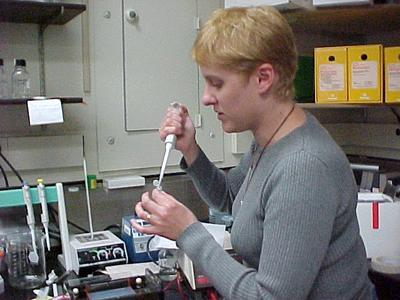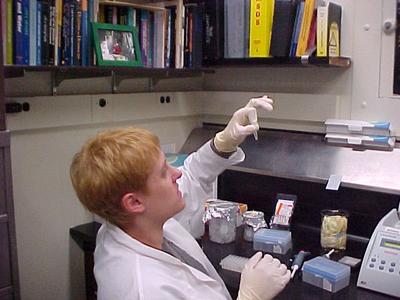
|
|
11 June, 2001

I flew into Albany, New York last night to meet Dr. Sam Bowser. The bumper on his car says, "I TREK". I'm not sure if that's because he journeys to Antarctica (this will be his 9th field season in Antarctica), or if it's because he is a Star Trek fan. During our discussion on foraminifera, he gave me a little something to read for the night; a teacher's guide to foramanifera. Who would have ever thought that I would be so excited about homework! I found the teacher's guide on forams to be very helpful before my visit to his lab today. [Forams are one-celled organisms in the kingdom called Protists. There are five "Kingdoms of Life": Plants, Animals, Bacteria, Fungi, and Protist.]

Today in the lab, I spent a good part of the day with Dr. Andrea Habura and Mary Cosgrove, a biology teacher from the College of St. Rose. Dr. Habura is a research affiliate at the Wadsworth Center assisting with Dr. Bowser's project. Her study of molecular evolution, in conjunction with Dr. Bowser's cell biology approaches, greatly enhances their knowledge of forams. Dr. Habura gave me my first glimpse into the exciting study of DNA (Deoxyribonucleic acid), the genetic "blueprint" of a cell. She also led me to a great web site about DNA. You may want to check out this wonderful and informative tutorial from the Cold Spring Harbor Laboratory: http://vector.cshl.org. Click on "DNA from the Beginning." You will need to download "Flashplayer".

Wadsworth Center Lab: What about DNA? Dr. Habura is using "known" foram species to identify their unique DNA sequence. In the process, she is building a database, so that when Dr. Bowser sends foram-laden sediment from Antarctica, they will be able to determine if it contains known species, or whether there are new species hiding within. Dr. Habura's work involves creating "DNA signatures" for the forams that will be collected by Dr. Bowser and his team of scuba divers while in Antarctica. If this works, then Dr. Bowser will be able to use the series of "DNA templates" created by Dr. Habura in the lab to chart seasonal changes in foram populations. Sending back frozen sediment without having to count and sort each foram will save valuable time. Dr. Bowser gave me two easy-to-read books, which helped me learn more about DNA and the basic biology involving cell structure. Instant Biology by Boyce Rensberger (ISBN # 0-449-90701-5) and The Way Life Works by Mahlon Hoagland and Bert Dodson (ISBN # 0-8129-2888-1) In order to truly appreciate the work that Dr. Habura and Dr. Bowser are doing, it would be helpful for you to know something about DNA. As children, we learn 26 letters of the alphabet which assemble together to make up words and sentences. DNA only has four letters (A, T, G, and C), which represent the four chemical parts inside genes that make up the sequence of information, or genetic code. DNA is made up of four chemicals: Adenine, Thymine, Guanine, and Cytosine, which can be linked in any sequence to form a message to be read by the cells. This information is stored inside genes to be passed from one generation to the next. It's like a "set of instructions" written in code, which tells the cells what to do in order to keep living. There are thousands of genes in a human cell, and there are billions of cells in our bodies=85all working together to maintain life. It's quite amazing to think that our research in Antarctica will involve the study of foraminifera, organisms about the size of a fingernail, which only have one cell!
Contact the TEA in the field at
.
If you cannot connect through your browser, copy the
TEA's e-mail address in the "To:" line of
your favorite e-mail package.
|
